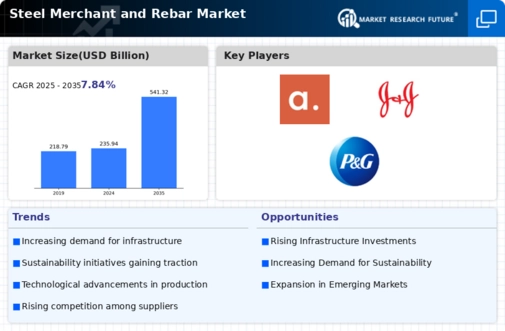Urbanization Trends
Rapid urbanization across various regions is significantly influencing the Global Steel Merchant and Rebar Market Industry. As populations migrate to urban areas, the demand for housing and commercial spaces rises, necessitating the use of steel and rebar in construction. According to estimates, urban areas are projected to house nearly 68 percent of the global population by 2050. This urban expansion is likely to drive the market, as the need for durable and sustainable building materials becomes more pronounced. Consequently, the market is expected to grow substantially, reaching 541.32 USD Billion by 2035.
Global Economic Growth
The overall global economic growth is a crucial factor influencing the Global Steel Merchant and Rebar Market Industry. As economies expand, the demand for construction and infrastructure development typically increases, leading to higher consumption of steel and rebar. Emerging economies, in particular, are experiencing rapid growth, which contributes to the rising demand for steel products. This trend is expected to bolster the market, with projections indicating a significant increase in market size over the next decade. The anticipated growth trajectory suggests a robust market environment, driven by economic expansion and increased construction activities.
Infrastructure Development
The ongoing global infrastructure development initiatives are a primary driver for the Global Steel Merchant and Rebar Market Industry. Governments worldwide are investing heavily in infrastructure projects, including roads, bridges, and buildings, which require substantial quantities of steel and rebar. For instance, the United States has proposed significant funding for infrastructure improvements, which is likely to boost demand for steel products. This trend is expected to contribute to the market's growth, with projections indicating a market size of 235.94 USD Billion in 2024, reflecting the increasing reliance on steel in construction.
Sustainability Initiatives
The growing emphasis on sustainability and eco-friendly construction practices is reshaping the Global Steel Merchant and Rebar Market Industry. As environmental regulations become stricter, the demand for recycled steel and sustainable materials is on the rise. Many construction companies are now prioritizing green building practices, which often involve the use of steel due to its recyclability and durability. This shift towards sustainable construction is likely to drive market growth, as stakeholders increasingly seek materials that align with environmental goals. The market's evolution in this direction may further enhance its appeal to investors and consumers alike.
Technological Advancements
Technological advancements in steel production and processing are transforming the Global Steel Merchant and Rebar Market Industry. Innovations such as automation and improved manufacturing techniques enhance efficiency and reduce costs, making steel products more accessible. For example, the adoption of electric arc furnaces has revolutionized steel production, allowing for more sustainable practices. These advancements not only improve the quality of steel but also cater to the increasing demand for high-performance materials in construction. As a result, the market is poised for growth, with a projected CAGR of 7.84% from 2025 to 2035.
Market Trends and Projections
The Global Steel Merchant and Rebar Market Industry is characterized by various trends and projections that illustrate its growth potential. The market is expected to reach 235.94 USD Billion in 2024 and is projected to grow to 541.32 USD Billion by 2035, indicating a robust growth trajectory. The CAGR of 7.84% from 2025 to 2035 reflects the increasing demand for steel products driven by infrastructure development, urbanization, and sustainability initiatives. These trends suggest a dynamic market landscape, where stakeholders must remain agile to capitalize on emerging opportunities.















Leave a Comment